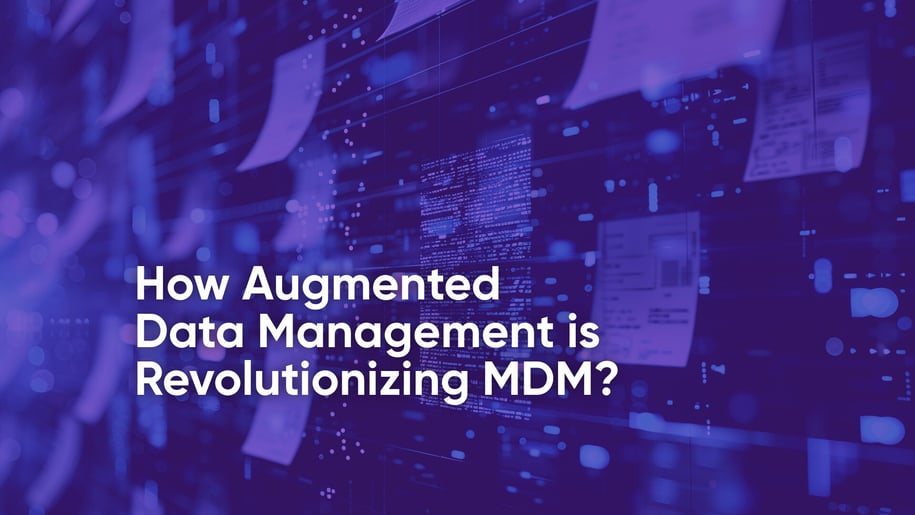
Augmented Data Management can provide valuable capabilities to support MDM initiatives by leveraging advanced technologies, increasing operational efficiency, and improving decision-making.
It may sound sensationalist, but it is inarguably true that the speed of technological evolution is at an all-time high. However, this rapid pace of change is exciting enterprises on the one hand; on the other hand, it is making them nervous. With AI (Artificial Intelligence), ML(Machine Learning), and NLP (Natural Language Processing) impacting every business, no industry is ever going to be the same again. Old methods are giving way to new techniques of doing things that are faster, simpler, and a lot more effective. Master data management (MDM) is no different and is undergoing significant changes. The MDM, which existed for the past two decades and was seen as time-consuming, costly, and overly dependent on IT, is now past us. The era of augmented data management (ADM) is now upon us. Here we look at how master data management (MDM) is getting revolutionized by ADM and what advantages it offers to businesses.
What is Augmented Data Management (ADM)?
Augmented data management (ADM) is an approach wherein AI, ML, Data automation, Graph, NLP are applied for data management and optimization. It complements human intelligence by aiding human capabilities and cognition to manage data to increase efficiency, decrease costs, enhance data quality, improve governance and decision-making, while doing away with repetitive tasks and creating more value in less time. It is meant to empower IT and data engineering teams as well as enable business users to take the lead in initiatives related to insights and analytics. Being cloud native, ADM offers cloud readiness and scalability, thereby offering the ability to handle a vast volume and variety of data.
Why Need Augmented Data Management?
Augmented data management techniques are already being used to address time and/or labor-intensive tasks, for instance, profiling data, eliminating data redundancies, applying policy rules, configuration management, and modifying performance. However, there are more reasons to implement it.
Augmented data management is brilliant at detecting outliers and anomalies and suggesting modifications, for instance, pattern recognition, automatic spotting, and concealing personally identifiable information like passport, date of birth, etc. Besides, as opposed to traditional data management, which involves collecting, storing, securing, controlling, and carrying out jobs such as filtering, copying, and tagging, ADM takes out a whole lot of manual tasks from the equation.
Augmented Data Management Best Practices for MDM
Some of ADM’s best practices for MDM relate to the following:
- Master Data Repository: ADM helps in building a master data model by collecting information from various departments through locating and analyzing master data and creating a single, trusted data repository.
- Data Quality Management: By employing advanced analytics methodologies, data can be quickly enhanced. One of the ways is by applying ‘time series forecasting,’ ‘SQL rules for distinctiveness, ‘completion,’ and ‘consistency.’
- Data Integration (Real-Time): ADM aids the creation of a unified view of data from distinct sources to offer recommendations and ease real-time integrations. These integrations are facilitated by API for creating dynamic data destinations and flexible access to data.
- Metadata Management: ADM helps create metadata models and rules, including gathering technical and business metadata. The organizing, cataloging, and merging of structured and unstructured data happen automatically.
Benefits of Augmented MDM
ADM fits organically with MDM by letting organizations address two of their primary goals, i.e., to ensure optimized business operations for efficiency and driving business growth. Compliance with changing regulations, risk managing ability, and data governance are certain other areas that ADM lets master data management improve. From a granular perspective, the chief benefits of augmented MDM are:
- Quicker Data Readiness: ADM automates data preparation by leveraging AI/ML hence readying it quickly.
- Enhanced Data Literacy: ADM eases data understanding by simplifying the findings for employees and partners.
- Analytics-backed Decision-Making: ADM takes out any kind of biases by establishing decision-making on hard facts, statistics, and analysis.
- Smarter and Faster Insights: ADM speeds up unearthing segments and clusters of interest, finds correlations, and discovers outliers quickly.
- Better Revenue: ADM directly impacts revenue by providing better data visibility, speeding up processes, and driving personalization and automation.
Future Trends in Augmented Master Data Management
ADM’s adoption in MDM is growing at a tremendous speed. Some of the trends which have already taken root, and are here to stay, are:
- Predictive Analytics: ADM will enable it further through ML-based algorithms that can examine data patterns and offer precise insights.
- NLP: Already generating a lot of interest, it is going to help MDM even more by improving efficiency, accessibility, and ease of use.
- Sentiment Assessment: By recognizing sentiments present in data, MDM can make amendments to make it more valuable and acceptable for its partners and customers.
- Recognition (image and video): Recognition of imagery, barcodes, or QR codes present on images and videos helps spot assets and products faster.
- Inconsistency Spotting: Spotting irregularities or inconsistencies correctly and instantly will gain momentum to avert errors and build failsafe MDM foundations.
Wrapping Up
Augmented data management helps identify associations among large datasets, thereby expanding the capabilities of MDM, especially when it comes to data and analytics. MDM providers have started combining augmented MDM to their solution to recognize associations among previously unknown data and have acquired the ability to tie them back to master data objects. It has unlocked a whole new world of contextual master data management where data objects are depicted within a particular context or business process.
With the backing of graph, AI/ML capabilities augmented MDM is aiding data management leaders to ensure maximum leverage can be taken from their master data and sharper contextual insights can be gleaned more efficiently and quickly.
Want to explore how Pimcore MDM can help you in data-driven decision making.
Related Insights:
.png?width=520&height=294&name=Blog%20Header%20Template%20Nov%202024%20(1).png)


